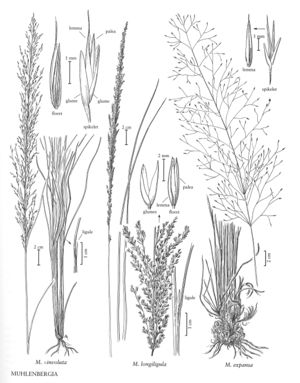Difference between revisions of "Muhlenbergia expansa"
FNA>Volume Importer |
FNA>Volume Importer |
||
| Line 20: | Line 20: | ||
-->{{Treatment/Body | -->{{Treatment/Body | ||
|distribution=Va.;Ga.;Tex.;La.;Ala.;N.C.;S.C.;Miss.;Ky.;Fla. | |distribution=Va.;Ga.;Tex.;La.;Ala.;N.C.;S.C.;Miss.;Ky.;Fla. | ||
| − | |discussion=<p>Muhlenbergia expansa grows in perennially moist to wet soils in pitcher plant bogs, pine savannahs, and flat-woods, usually in sandy soils and at elevations of 0-300 m. Its primary range is the coastal plain of the south-eastern United States.</p> | + | |discussion=<p><i>Muhlenbergia expansa</i> grows in perennially moist to wet soils in pitcher plant bogs, pine savannahs, and flat-woods, usually in sandy soils and at elevations of 0-300 m. Its primary range is the coastal plain of the south-eastern United States.</p> |
|tables= | |tables= | ||
|references= | |references= | ||
| Line 41: | Line 41: | ||
|publication year= | |publication year= | ||
|special status= | |special status= | ||
| − | |source xml=https://jpend@bitbucket.org/aafc-mbb/fna-data-curation.git/src/ | + | |source xml=https://jpend@bitbucket.org/aafc-mbb/fna-data-curation.git/src/8f726806613d60c220dc4493de13607dd3150896/coarse_grained_fna_xml/V25/V25_767.xml |
|subfamily=Poaceae subfam. Chloridoideae | |subfamily=Poaceae subfam. Chloridoideae | ||
|tribe=Poaceae tribe Cynodonteae | |tribe=Poaceae tribe Cynodonteae | ||
Revision as of 16:34, 18 September 2019
Plants perennial; cespitose, not rhizomatous. Culms 60-100 (150) cm, erect from the base, not conspicuously branched; internodes mostly glabrous, sometimes puberulent below the nodes. Sheaths glabrous or puberulent, rounded basally, becoming fibrous, not flat or spirally coiled, at maturity; ligules 1.8-5(10) mm, membranous, firm, strongly decurrent, obtuse; blades 20-50(80) cm long, 2-4 mm wide, flat or involute, smooth abaxially, scabrous adaxially. Panicles 15-50(60) cm long, 5-30 cm wide, longer than wide, diffuse; primary branches 2-20 cm, capillary, spreading 30-100° from the rachises, naked basally, lower branches with 5-20 spikelets; pedicels 4-50 mm, longer than the spikelets, capillary, flexible, widely divergent at maturity. Spikelets 3-5 mm, often purplish, sometimes brownish or bronze. Glumes subequal, 1.5-3.3 mm, shorter than the florets, glabrous; lower glumes 1-veined, unawned; upper glumes usually 1-veined, rarely 3-veined, acute to acuminate, often erose, sometimes mucronate; lemmas 3-5 mm, lanceolate, calluses shortly pubescent, apices acuminate, without setaceous teeth, usually unawned, if, as rarely, awned, awns 1-3 mm, clearly demarcated from the lemma bodies; paleas 2-4.5 mm, lanceolate, acuminate, unawned; anthers 1.5-2 mm, purple. Caryopses 2-2.5 mm, narrowly elliptic, brownish. 2n = unknown.
Distribution
Va., Ga., Tex., La., Ala., N.C., S.C., Miss., Ky., Fla.
Discussion
Muhlenbergia expansa grows in perennially moist to wet soils in pitcher plant bogs, pine savannahs, and flat-woods, usually in sandy soils and at elevations of 0-300 m. Its primary range is the coastal plain of the south-eastern United States.
Selected References
None.
